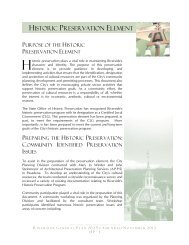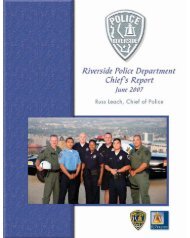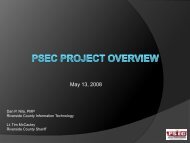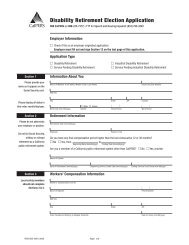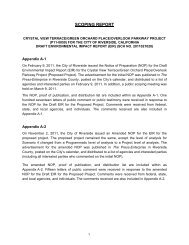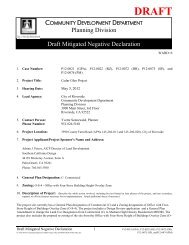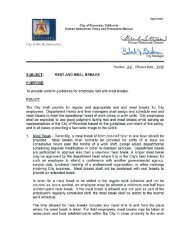Northside - City of Riverside
Northside - City of Riverside
Northside - City of Riverside
You also want an ePaper? Increase the reach of your titles
YUMPU automatically turns print PDFs into web optimized ePapers that Google loves.
prevalence is unknown. Another description from the 1902 Sears Catalogue helps<br />
illuminate both the uncommonness <strong>of</strong> domestic bathtubs and the health-related<br />
desire for full immersion bathing:<br />
A desirable necessity is to be found in Cline’s Portable Shower Bath.<br />
No home is complete without a bath. As many homes are not provided<br />
with a tub, this little portable bath is constructed to fill the long felt<br />
want, for a small cost and no trouble. A full, invigo rating, life giving<br />
bath, such as your physician prescribes; always re ady.<br />
Whatever the private bathing amenities <strong>of</strong> Victorian <strong>Riverside</strong>, the plunge was such<br />
a draw for local residents that a second well was dug to 370 feet in 1900, which<br />
secured a continuous flow <strong>of</strong> 50,000 gallons per day. A small motor later increased<br />
the flow to 200,000 gallons per day, which were emptied from the pool each night<br />
and flowed down Strong Street. By the early 1900s, the ultra-pure water <strong>of</strong> the<br />
mineral spring was being bottled onsite and sold for table water in great quantities<br />
as far as Los Angeles, and the clear waters were a draw for Hollywood film stars<br />
and makers alike such as Buster Keaton, Annette Kellerman, and The Great<br />
Houdini, who in 1919 dived to the bottom <strong>of</strong> the Elliotta Plunge to release a woman<br />
from a safe (Patterson 1964:82; Hall 1996:121-24).<br />
Throughout the early 20 th century, local <strong>Northside</strong>rs frequented the plunge, and<br />
visitors and downtown residents were bussed in from the Mission Inn for a dime<br />
(WSSP c. 1960s), but the depressed 1930s led to decreased activity at the resort. In<br />
1937, Dr. N.C. Heron <strong>of</strong> Los Angeles purchased “Elliotta Plunge,” which was as<br />
<strong>of</strong>ten called Elliotta Springs, and demolished it for the construction <strong>of</strong> a thenmodern<br />
sanitarium and health resort, which centered on the production <strong>of</strong> Dr.<br />
Heron’s specialty, medicinal eucalyptus oil. The plunge closed in the summer <strong>of</strong><br />
1937 for the planting <strong>of</strong> a Eucalyptus grove and the construction <strong>of</strong> the new facilities,<br />
which were completed in 1939 (<strong>Riverside</strong> Press c. 1937:n.p.). It appears that<br />
remnants <strong>of</strong> this Eucalyptus grove are still extant on the property.<br />
Throughout the 1940s, Heron’s Plunge continued to serve local residents as a spot <strong>of</strong><br />
informal recreation and also as one for large parties and events. In 1946, the plunge<br />
was the site for the Calectric Women’s Picnic and Swimming Party, and <strong>Northside</strong>rs<br />
remember it well as a place to go for special times like birthday celebrations<br />
(Mermilliod & Klure 2005b). In the late 1940s, the pool and buildings were entirely<br />
rebuilt by Frank Heron, son to Dr. Heron (WSSP c. 1960s).<br />
In 1958, Ray and Virginia Morissette purchased “Heron’s Plunge” and the<br />
associated buildings. As part <strong>of</strong> the improvements the Morissettes made, the mineral<br />
baths were separated from the main pool, and badminton and volleyball courts were<br />
added as well as a shuffleboard deck and water slide (Daily Press 1959:B-10). By<br />
55



